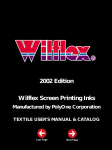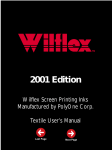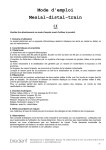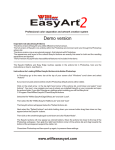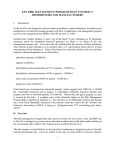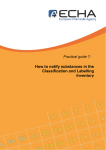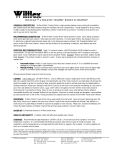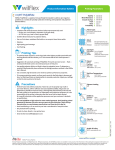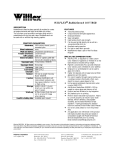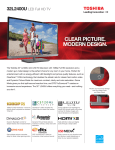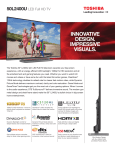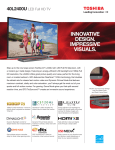Download wilflex standard plastisol colors process
Transcript
Sorry, the below colors cannot be represented with any similarity to the original on a computer monitor. WILFLEX STANDARD PLASTISOL COLORS 81000 Lemon Yellow GNS, MSH, NPF, OSN, TF 82500 Yellow GNS, MSH 80100 Light Gold NPF, OSN, TF PROCESS COLORS 80000 Gold NPF, OSN 69850 Process Cyan GNS, TF (69858) 49850 Process Magenta GNS, TF (49858) 89850 Process Yellow GNS, TF (89858) 69855 Process Tone Cyan GNS 49855 Process Tone Magenta GNS 89855 Process Tone Yellow GNS 19850 Process Black (GNS) or 19000 Transflex Soft Black (TF) for transfers can be used with either set of process colors. Chips are only approximations of actual colors. Color value data is available for download on www.wilflex.com. 30400 Dolphin Orange GNS, MSH, TF 30200 Bright Orange GNS, MSH, OSN, TF 485CSB Pantone® 485 C Simulation 40000 Scarlet GNS, MSH, NPF, OSN, TF 43000 National Red GNS 42000 Dallas Scarlet GNS, MSH 45800 Russell Cardinal GNS, MSH, TF 48600 Burgundy GNS 45400 Maroon OSN, MSH 47600 Brandywine GNS 50200 Purple GNS, NPF, TF 50400 Russell Purple GNS, MSH, OSN 60000 Navy Blue GNS, MSH, NPF, OSN, TF 66100 Bear’s Navy GNS 62100 Light Royal GNS, MSH, NPF, OSN, TF 60420 Deacon Blue GNS WILFLEX FLUORESCENTS 60650 Contact Blue GNS, OSN, TF 68500 Winter Blue GNS, TF 75300 Turquoise GNS, NPF, TF 90000 Fluorescent Yellow GNS, NPF, TF 90010 Super Fluo. Yellow GNS 90300 Fluorescent Orange GNS, NPF, TF 90310 Super Fluo. Orange GNS 90600 Fluorescent Red GNS, TF 90610 Super Fluo. Red GNS 90400 Fluorescent Pink GNS, NPF, TF 90410 Super Fluo. Pink GNS 90700 Fluorescent Magenta GNS, TF 90710 Super Fluo. Magenta GNS 90100 Fluorescent Blue GNS, NPF, TF 90800 Fluorescent Purple GNS 90810 Super Fluo. Purple GNS 90200 Fluorescent Green GNS, NPF, TF 90210 Super Fluo. Green GNS 90110 Super Fluo. Blue GNS 67800 Deep Aqua GNS 70500 Dallas Green GNS, MSH, TF 70000 Kelly Green GNS, MSH, NPF, OSN, TF 75900 Black Light Green GNS, NPF 23800 Spice Brown GNS, NPF, OSN, TF 20100 Dark Brown GNS, MSH, TF 13300 Russell Gray GNS 14600 Dark Gray GNS, TF 12600 Rebel Flesh GNS WILFLEX SPECIALTY COLORS WILFLEX SUPER OPAQUE PLASTISOL COLORS 87030 Super Primrose GNS 87020 Super Lemon Yellow GNS, TF 80100 Super Light Gold GNS, MSH, TF (80101) 99900 Phosphorescent GNS 15340 Yellow Sparkle IS 15370 Silver Shimmer MCVFF, TF 15055 Silver Metallic MET 85370 Gold Shimmer MCVFF 85075 Solid Metallic Gold MET 85065 Pure Gold Metallic MET 85570 Ultra Gold Shimmer MCVFF, TF 85085 Bright Copper MET 86065 Gold Glitter GT 16055 Silver Glitter GT Natural Suede M. Brown 29111NS 80010 Athletic Gold SSV 80000 Super Gold GNS, MSH 42270SB Super Drake Red SB 30401 Super Dolphin Orange GNS 34800 Super Clockwork Orange GNS, TF 40500 Super Red GNS, TF 57010 Super Purple GNS, TF 47030 Super Fuchsia GNS, TF 67040 Super Bright Blue GNS, TF 67050 Super Royal GNS, TF 60007 Super Marine Blue GNS 75301 Super Turquoise GNS, TF 70501 Super Dallas Green GNS, TF 75601 Super Spring Green GNS, TF WILFLEX PRODUCT DESCRIPTIONS OTHER PRODUCTS FROM WILFLEX Genesis (GNS) High production, automatic or wet-on-wet printing. Wide range of standard colors, use with colored substrates or over a flashed white. Excellent printability, minimal build-up. Use for fine detail or halftone printing. Genesis Super colors give maximum opacity on dark fabrics. Genesis 4-color process, tone colors and phosphorescent available. Color Systems MX Mixing System ● A simple finished ink system for simulating PANTONE® colors with just 15 components. Designed for general purpose printing. ● Prints feature vibrant colors and a matte finish. ● MSH Nylon Series - MX lookalike system for creating PANTONE® simulations on uncoated nylon mesh, including porthole, micromesh and dazzle cloth. SuperBase (SB) General purpose base exhibits a soft hand, with a matte finish and is one of Wilflex's most opaque bases. Advanced technology allows creamy viscosity SuperBase to be pumped. Virtually build-up free, an added benefit for high productivity printers. NuPuff (NPF) Industry standard for plastisol puff effects. Suitable for use on light or dark garments; good opacity. Flash or overprint for dramatic effects. PC Express A pigment concentrate and base system used to achieve PANTONE® simulations and thousands of custom colors with just 15 pigment concentrates, including black and white. ● Used with 10680GNS Genesis Plus general purpose base. ● Equalizers/ColorMaster Equalizers are a set of balanced pigment concentrates used as colorants to General Purpose Bases. ● Equalizers are optimized for 21000SB. ● ColorMaster pigments are available in the same hues, but at increased strengths. ● ColorMaster pigments are designed exclusively for use with automated dispensing equipment. ● SSV-FF/MCV-FF “Fast fusion” inks designed to cure at temperatures of 270 F (132 C). SSV-FF for dark colored substrates, good opacity. MCV-FF for light colored substrates, may be printed wet-on-wet. Excellent elongation, suitable for many stretch fabrics, heat sensitive fabrics or carpets. **Standard colors available only in white, black and some specialty colors. Create additional colors by using PCs and fast fusion bases. MSH Athletic ink suitable for uncoated nylon mesh. Excellent durability and adhesion with a gloss finish. Available in a number of standard colors plus as a mixing system suitable for simulating coated and uncoated PANTONE® Color Formula Guide colors and SGMA colors. Special SSV Athletic Gold shades available to print a bleed-resistant, heavy deposit of ink on cottons and blends: SSV Athletic Gold 80010, Athletic Light Gold 80110 and IS Omni Gold 88800 (80110 and 88800 not shown on color card). One Step Nylon (OSN) One-part ink eliminates mixing and waste ink when printing on untreated nylon. Use like standard plastisol, won't dry in screen or harden in container. Wide range of colors available; flashes quickly, excellent for multi-colored designs. Addition of catalyst necessary when printing on waterproofed nylon. Transflex (TF) Use for hot-split or cold-peel transfers. Soft hand, highly durable. TF Super inks for high opacity, TF process and metallic/shimmer inks available. Excellent color, printing properties and wash fastness. TF suede-feel One PacPuff and TF Printable Adhesive available. Specialty Inks Wilflex sells a wide variety of specialty inks, including glitters, shimmers, phosphorescent, Reflective 10015IS, High Density additives, High Density Clear 10009HDC and Rock Base 10670RB inks. Natural Suede is available as a base (10425NS) or in three standard colors: Black 19111NS, Medium Brown 29111NS or Dark Brown 29222NS. Whites Wilflex sells a variety of white inks for specific applications: ● Xtreme White 11999XW - general purpose white ● Bright Tiger 11480HT - general purpose white ● PolyWhite 11117HT - printing on polyester ● Pennant White 11000PEN - printing on nylon ● Athletic Trophy White 11003WHT - athletic applications ● Olympia Plus White 11135WHT - 100% cotton Additives Wilflex additives include reducers, thickeners and extenders. ● Viscosity Buster 10025VB - improves flow properties of white inks and reduces tack of white and MSH inks. ● Curable Reducer 10070 - viscosity reducer that cures at standard cure temperatures (320 F/160 C), ensuring lower viscosity without fear of cure problems. ● Thickeners 1, 2 and 3 ● Finesse 10150FNS, Soft Hand Clear 10140CLEAR - soften and extend inks, for easier printability and softer hand We also sell miscellaneous additives such as Dulling Additive, puff and flash additives plus High Density and Stretch additives. All Wilflex inks are formulated to print on textiles. Unless otherwise noted, Wilflex inks must reach 320 F/160 C to cure and give designed characteristics.The information above is given in good faith, but preprinting and testing for desired properties are strongly recommended. Please consult the Wilflex Textile User's Manual or your Wilflex representative for more information on Wilflex products. PANTONE® is a trademark of Pantone, Inc. All trademarks noted herein are either the property of PolyOne Corporation, Pantone, Inc. or their respective companies. Wilflex ink formulations for screen process printing produce simulations of PANTONE® Colors in this color reproduction method due to differences in ink film, opacity, pigment selection, and substrate. The color chips presented on this Color Card are simulations of Wilflex colors. Slight color variations may be seen between these chips and actual Wilflex inks. Not all ink ranges are available in every country. TEXTILE SCREEN PRINTING INKS www.wilflex.com Evaluation of Plastisol Inks It is important to always pre-test plastisol inks before commencing production runs. Wash Testing Plastisols for Cure Failure to cure ink properly can result in poor wash fastness, inferior adhesion, unacceptable durability and increased likelihood of dye migration. Maximum ink tensile strength and elongation is accomplished by ensuring total fusion of the ink film. Testing procedures include wash testing and testing with solvent, with wash testing being the more reliable method. A wash test ensures that printed samples are subjected to standard home laundering practices to determine state of cure on ink film. Apparatus and materials include: Large capacity 21.7-gal washer, large capacity 240-volt dryer, three large heavyweight, bath-size towels. Procedure 1. Cut printed sample to be tested in half. 2. Place half of sample in washer with the three large bath towels. 3. Wash settings: Medium load 16.7 gallons, hot wash/cold rinse, normal /reg. @ 10 minutes, 90ml of concentrated detergent 4. After washing is complete, place sample and towels in dryer. 5. Dryer Settings: Cotton/High (105°F/40°C)/timed dry 30 minutes 6. Perform two to five complete wash and dry cycles. 7. Compare washed half of sample with unwashed portion. Evaluation and Classification Failure - The ink film is not cured when: 1. Severe cracking of the ink is noted. 2. Partial or total loss of the ink film from the garment is seen. Pass - The ink is cured if none of the above is seen. Slight loss of color intensity (AATCC Gray Scale for evaluating change in color 4-5), and slight nap show-through are normal for cured ink films after washing. Solvent Cure Test Solvent testing is only the second most reliable method for testing plastisol cure. To test with solvent, follow these steps: Method #1: 1. Apply two or three drops of 99% ethyl acetate to the surface of the ink layer being tested. Warning! Ethyl acetate is poisonous and flammable. Always wear butyl or nitrile (not latex) rubber gloves and goggles when handling this chemical. Do not pour directly from the container onto the fabric. Use a glass eyedropper. 2. Fold the T-shirt so that the area of the ink film treated with the solvent is pressed against an unprinted area of the T-shirt. 3. Firmly press the two layers of fabric together with a small C-clamp or similar clamping device for two minutes. If any ink transfers from the printed area to the unprinted area, it is an indication that the ink film is not completely cured. Method #1 may give false positive results (the test indicates that the ink is completely cured but it is not) if the ink layer is extremely thick. If the ink layer is thick, use Method #2 when testing with solvent. Method #2: Use for Thick Ink Film 1. Apply two or three drops of solvent to the fabric on the inside of the T-shirt, behind a printed area. 2. Fold the shirt so that you can press the ink layer that has been treated with the solvent against an unprinted area of the shirt. or similar clamping device for two minutes. If any ink transfers from the printed to the unprinted area, the ink film may not be completely cured. Transfer Release Test It is important to conduct accelerated age tests in your plant, which will indicate how a transfer will release from the transfer paper after six months to one year “on the shelf.” Accelerated aging tests can be performed by placing the printed transfer in a hot box or hot room, at 100 hours at a temperature of 120 F. This will simulate one year of shelf life. Tests conducted in your plant will help keep your transfer/garment reject risk to a minimum. Bleed Test - When Printing Polyester-containing Substrates Since dye lot variation is very common, it is imperative to test a garment’s propensity for dye migration. Historically, fabrics containing polyester are more likely to bleed than any other fabrics whereas nylon and cotton much less likely to bleed. However, it is suggested that all dark fabrics that will be printed with white or light colored inks should be evaluated for bleeding. The bleeding phenomena occurs due to a reaction between the ink and the dyes of the fabric. The following is a test method evaluating the bleed potential of ink printed on a given fabric: 1. Bleed resistance (or the resistance of an ink to accept the dyes from polyester fabric) is determined by the chemistry of the ink, complete ink cure and by the ink deposit. Choose the screen mesh that duplicates the planned use of the white ink as well as two other possible combinations. 2. Print just the white ink on appropriate fabric swatches and hold for three weeks. After three weeks, visually evaluate the prints for whiteness. (You may choose to try accelerating this evaluation by holding the prints at 105 F/ 40 C for 2 to 5 days.) Fabric Discoloration Test - When Printing Cotton Substrates For direct print and transfer inks, it is extremely important to pre-test on dyed or stone washed garments. Avoid stacking hot, because such fabrics are more prone to color distortion due to the dye stuffs inherent in the garment. Fabric and dye characteristics can exhibit variance between manufacturers and from dye lot to lot. The following test will determine if the fabric dyestuffs are prone to discolor: 1. Print ink onto suspect fabric and fuse. 2. Cover the print area with a piece of the suspect fabric (sandwiching the print) and set in a heat press. 3. Set the heat press to 200 F and 5 PSI. 4. Close the transfer press and let sit for four hours before evaluation. If material is prone to discoloration, you will see a “ghost” image of your printed image on the material that was covering the printed area. Call Wilflex Technical Services for more information on pretest procedures 1-800-735-4353 3. Firmly press the two layers of fabric together with a small C-clamp PolyOne Formulators Group 8155 Cobb Center Drive Kennesaw, GA 30152 770.590.3500 800.326.0226 www.wilflex.com Wilflex Europe Ltd. Unit 12 Orbital One Green St. Green Rd. Dartford, Kent DA1 1QG (+44) 01322 277778 Wilflex Australasia Pty. Ltd. 77 Parkhurst Dr. Knoxfield 3180 Victoria, Australia (+61) 3 9887 1522



